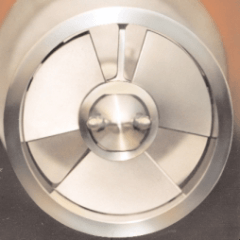Laboratory Homogenizers Information
 Laboratory homogenizers are high-speed, high-shear mixers that reduce samples to uniform-sized molecules through maceration, cutting, and blending. They are used to process liquids, slurries, or granular substances.
Laboratory homogenizers are high-speed, high-shear mixers that reduce samples to uniform-sized molecules through maceration, cutting, and blending. They are used to process liquids, slurries, or granular substances.
Specifications
Product specifications for laboratory homogenizers include:
- media viscosity
- capacity
- feed rate
- motor speed
- motor power
- pressure range
- operating temperature
Viscosity is a measure of a fluid’s thickness. Capacity is the volume of product that a laboratory homogenizer can accommodate. Feed rate measures product flow over a given period of time. Media characteristics such as pH concentration and specific gravity are also important considerations. Some laboratory homogenizers include an integral heating or cooling element. Others are intrinsically safe, explosion proof, or designed for sanitary applications.
Types
There are three basic types of laboratory homogenizers:
- fluidized bed
- rotor-stator
- ultrasonic
Fluidized-bed homogenizers are durable vessels that fluidize the complete product bed. Efficient and thorough, these laboratory homogenizers can achieve relatively fast rotational speeds, but require higher levels of applied horsepower (hp).
Rotor-stator homogenizers are single-shaft mixers with an impeller that rotates in close proximity to a stationary housing. The rotor imparts high shear forces mechanically while the stator directs the flow.
Ultrasonic, or vibrational, homogenizers apply ultrasonic waves in a mixed medium to produce a steep gradient of acoustical pressure and, therefore, fluid movement and a very-fine level of mixing action. Though inaudible to the human ear, these ultrasonic waves are capable of exerting pressures of more than 500 atmospheres (atm) and achieving temperatures of 5,000° C.
Features
Laboratory homogenizers differ in terms of mounting styles and user interface. Handheld, benchtop, portable, overhead, stand-mounted, and floor-mounted products are commonly available. Display type and local interface define the user interface. There are three basic display types: analog meter, digital numerical display, and video display. Analog meters have a dial or indicator lights. Video displays use a cathode ray tube (CRT), liquid crystal display (LCD), or other multi-line display. As a local interface, laboratory homogenizers may include an analog or digital front panel. An analog front panel has user inputs such as potentiometers, dials, and switches for the adjustment of outputs and ranges. A digital front panel features digital menus or keypads.
Laboratory homogenizers are used with a wide range of materials, but are best suited for high-moisture, high-fat, or fibrous products. In addition to homogenization, they are used in comminuting, deagglomerating, disintegrating, dispersing, and dissolving processes. Some laboratory homogenizers are also used in emulsification, extraction, gassing, mixing, precipitation, process reactions, shredding, and wetting applications.
Related Information
Engineering360—Processes Enabling Nanomanufacturing
Image credit:
